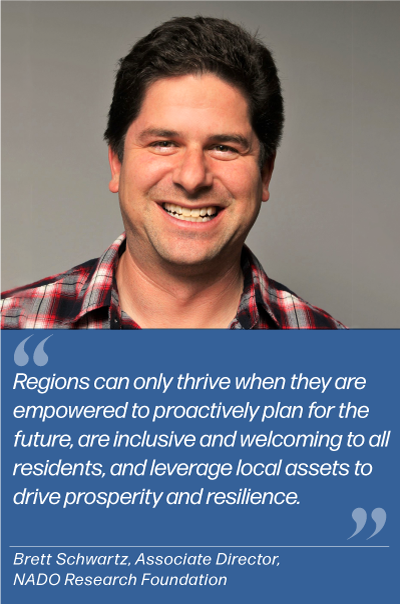User Spotlight
Brett Schwartz, Associate Director, NADO Research Foundation

Established in 1967, the National Association of Development Organizations (NADO) provides advocacy, education, research and training for the nation’s regional development organizations. Since 1988, its nonprofit research affiliate, the NADO Research Foundation, has been at the forefront of researching and sharing the latest innovative approaches to community development in regions across the United States.
In March 2022, we chatted with Brett Schwartz, Associate Director at the NADO Research Foundation, about promoting diversity, equity and inclusion in economic development, building capacity in rural areas through data, and how his team utilize StatsAmerica in their work.
Can you describe the mission of the NADO Research Foundation and how it engages with communities to achieve it?
Brett Schwartz:
The NADO Research Foundation (NADO RF) is the nonprofit research affiliate of the National Association of Development Organizations, a membership association of the country’s regional development organizations (RDOs). “RDO” is a term we use to describe multi-jurisdictional planning and development agencies, which are known locally as Councils of Governments, Economic Development Districts, Regional Planning Commissions, or by other names.
NADO RF was founded in 1988 and is at the forefront of researching and sharing the latest innovative approaches to regional economic development in small metropolitan areas and rural America. We provide training, research and peer networking services to RDOs and other partners in the areas of economic and climate resilience, regional wealth creation, transportation and professional development.
How does NADO RF encourage its stakeholders to use StatsAmerica tools and data? What are your go-to resources on the site?
The majority of NADO’s members are federally designated as Economic Development Districts (EDDs) by the U.S. Economic Development Administration (EDA). One of the requirements for achieving and maintaining this designation is for the EDD to write and update a Comprehensive Economic Development Strategy (CEDS). In a nutshell, the CEDS is a locally based, regionally driven economic development planning process and document that creates the space for a region to identify its strengths and weaknesses and brings together a diverse set of partners to generate good jobs, diversify the economy and spur economic growth.
For many years, NADO RF has provided training and technical assistance to EDDs to support with planning, writing and implementing the CEDS. We’ve pointed districts to StatsAmerica as an indispensable (and free!) resource to use while crafting the CEDS. In particular, the Measuring Distress, Regionizer and Big Radius tools have been helpful to collect and analyze information to include in the document. And, of course, the CEDS Resource Library has been a valuable repository for districts to quickly view and compare CEDS from across the country when looking for inspiration and best practices. All of these resources help EDD staff and their partners better tell the story of their region—where it has been, where it is now and where it is going.
How can regional development organizations incorporate diversity, equity, and inclusion into economic development planning? How can they harness data for these efforts?
NADO RF understands that regions can only thrive when they are empowered to proactively plan for the future, are inclusive and welcoming to all residents, and leverage local assets to drive prosperity and resilience. For the last several years, we have been working with regional development organizations as they strive to better incorporate equity and economic inclusion principles into their plans, programs and outreach efforts to ensure that all residents have an opportunity to be a part of shaping their community’s future.
We are fortunate to be a partner on the EDA-funded Inclusive Recovery Initiative project led by the New Growth Innovation Network. This effort is exploring ways to include equity and economic principles into the CEDS by providing technical assistance and facilitating a virtual community of practice. Interviews with staff at over 60 EDDs revealed that one of the top-five challenges facing organizations in supporting inclusive growth was a lack of understanding on how best to embed data on inequality into the planning process. Improved access to disaggregated data on diversity, equity and inclusion indicators will allow organizations to better address the needs and challenges of underrepresented communities in their regions. This can lead to more targeted and effective planning, programming, and interventions to address structural inequalities that are holding back regional prosperity.
What are some other resources you recommend to stakeholders for economic development tools and data?